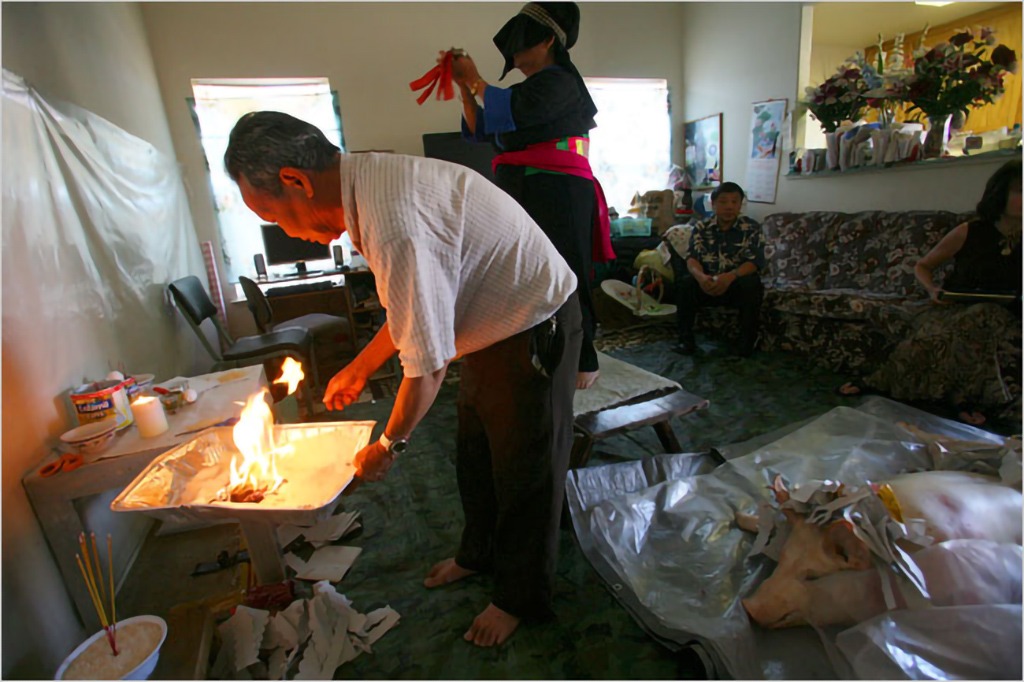
Hmong Shamanism
HMONG SHAMANISM

Religious Beliefs. The Hmong otherworld is closely modeled on the Chinese otherworld, which represents an inversion of the classical Chinese bureaucracy. In former times, it is believed, humans and spirits could meet and talk with one another. Now that the material world of light and the spiritual world of darkness have become separated, particular techniques of communication with the otherworld are required. These techniques form the basis of Hmong religion, and are divided into domestic worship and shamanism. Religious Practitioners. Every male head of a household practices the domestic worship of ancestral spirits and household gods represented at different sites in the architecture of the Hmong house. Particular rituals must be performed by him in honor of these spirits, most during the New Year celebrations.
Whereas domestic worship is conducted for the benefit of individual households by their heads, shamanism is only practiced by a few men in each lineage, and is for the benefit of others since its primary purpose is to cure illness. Illness is often diagnosed by the shaman as the result of soul loss; his task is to recall the wandering soul and so restore health. Supernaturals. The two malevolent Lords of the otherworld are Ntxwj Nyug and Nyuj Vaj Tuam Teem. Saub is a kindly deity who periodically comes to the rescue of humanity, and Siv Yis was the first shaman, to whom Saub entrusted some of his healing powers to protect humankind from the diseases with which Ntxwj Nyug afflicted them. Household and ancestral spirits ( dab ) are distinguished from the tutelary spirits of the shaman ( neeb ). Within the household there are special altars to the spirits of wealth and sickness, of the bedroom, the front door, the loft, the house post, and the two hearths. Ceremonies.
The major calendrical ceremony is New Year, when the household spirits are renewed, the ancestral spirits honored, and the shamanic spirits dispatched temporarily to the otherworld. New clothes are donned, parties of villagers visit other villages, antiphonal songs are sung by courting couples, and courting games of catch are played. Each household sacrifices domestic animals and holds feasts. Weddings are also celebrated with great display. Arts. Needlework, embroidery, and the chanting of love songs are particularly esteemed artistic skills. The playing of the reed pipes, the notes of which are said to express the entirety of Hmong customs, is an art that takes many years to acquire. New dances, song forms, and pictorial arts have appeared in the context of the refugee camps. Medicine. Herbal medicine is a specialty of many women who maintain special altars to the spirits of medicine. Forms of massage and magical therapy are also used.
Shamanism remains the primary medical and therapeutic technique, although modern medicines are employed extensively. Death and Afterlife. The ritual specialist at death is not necessarily a shaman, whose business is to preserve life. The purpose of the funeral and mortuary rites is to ensure the safe dispatch of the reincarnating soul to the otherworld. Funerals last a minimum of three days, attended by all local male kin within the household of the deceased. The reed pipes are played each day and a special song is sung to guide the reincarnating soul on its journey. Cattle must be slaughtered. The corpse of the deceased is inhumed in a geomantically selected site. On the third day after burial the grave is renovated, and a special propitiatory ritual is performed thirteen days after death for the ancestral soul, which will protect the household.
A final memorial service to release the reincarnating soul, held a year after death, is somewhat similar to the funeral; and some years after death, in the case of severe illness or misfortune, a special propitiatory ritual may be performed for the same spirit. On the way back to the village of its ancestors, the reincarnating soul must collect its “coat,” or placenta, buried beneath the floor of the house. The dangers and pitfalls of this journey are pictured in the poetic geography of the funeral song, which parallels the long historical journey of the Hmong from a country probably to the north of China. The song describes the creation of the first couple, the deluge, and the first drought, and represents a historical journey back to the origins of humanity, to which the deceased must return before being reborn. Read more: Religion and expressive culture – Hmong www.everyculture.com.





Responses